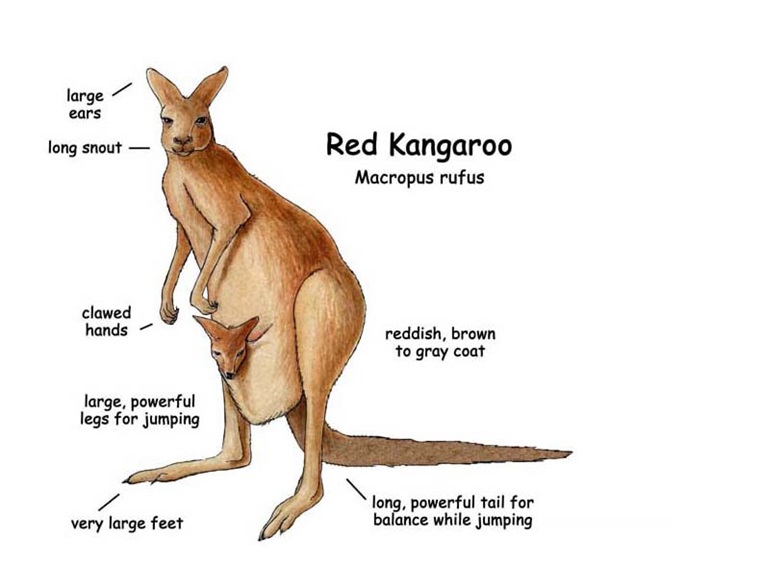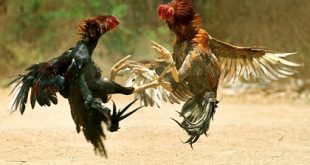Kangaroos are fascinating marsupials native to Australia, and their unique anatomy enables them to thrive in diverse environments. Each part of their body has evolved to perform specific functions that contribute to their survival. This article delves into the various body parts of a kangaroo, exploring their structure and the essential roles they play in the kangaroo’s life.
A Body Part of A Kangaroo

1. Powerful Hind Legs
One of the most defining features of a kangaroo is its powerful hind legs. These legs are elongated, muscular, and equipped with large tendons, allowing kangaroos to hop efficiently. This method of locomotion, known as saltation, is energy-efficient and enables kangaroos to travel long distances at speeds of up to 35 miles per hour (56 km/h). The elastic tendons in their legs store energy as they land and release it as they push off, reducing the physical effort required.
- Efficient Travel: In the vast Australian outback, food and water sources can be far apart. Hopping allows kangaroos to cover large distances quickly.
- Escape from Predators: Their powerful leaps, sometimes covering over 25 feet in a single bound, help them evade predators like dingoes.
Additionally, the hind legs are used for defense. Kangaroos can deliver powerful kicks with their legs, which can deter or injure threats.
2. Large Feet
The hind legs are complemented by large feet. These feet have a strong central toe with a sharp claw, which aids in gripping the ground during hopping and provides stability. The sharp claws are also used in combat, particularly by males during fights for dominance.
3. Long, Muscular Tail
The tail of a kangaroo is another distinctive feature. It is long, muscular, and serves multiple functions:
- Balance: While hopping, the tail acts as a counterbalance, helping the kangaroo maintain stability.
- Support: When standing or moving slowly, kangaroos often use their tail as a third limb, creating a tripod-like support system. This is particularly useful when grazing or fighting.
- Communication: The tail can also be used to signal other kangaroos, especially during social interactions.
4. Strong Forelimbs
Kangaroos have relatively small but strong forelimbs, which end in five-digit hands with sharp claws. These forelimbs are versatile and perform several functions:
- Grooming: Kangaroos use their hands to groom themselves and their joeys, removing dirt and parasites from their fur.
- Feeding: They use their hands to manipulate food, bringing grass and leaves to their mouths.
- Fighting: During fights, particularly among males, forelimbs are used to grab and hold opponents while delivering kicks with their hind legs.
5. Pouch (Marsupium)
A hallmark of all marsupials, the pouch is a crucial body part for female kangaroos. Located on their abdomen, the pouch provides a safe and nurturing environment for their underdeveloped young, called joeys.
- Protection: Joeys are born extremely underdeveloped, resembling a jellybean. They crawl into the pouch immediately after birth and remain there for several months, latching onto a teat for nourishment.
- Feeding: The mother’s body adjusts milk composition depending on the joey’s developmental stage.
- Mobility: The pouch allows the mother to carry her young while moving freely, ensuring their safety from predators.
6. Unique Teeth
Kangaroos have specialized teeth adapted to their herbivorous diet. Their dental structure includes:
- Incisors: Located at the front of their mouths, these teeth help kangaroos clip grass and other vegetation.
- Molars: At the back, molars are used for grinding food. These teeth are unique because they move forward in the jaw as they wear down, ensuring the kangaroo can continue eating effectively throughout its life.
The constant regrowth and replacement of teeth are vital for survival in the harsh Australian landscape, where food can be tough and abrasive.
7. Large Ears
Kangaroos have large, sensitive ears that can swivel independently to detect sounds from various directions. This acute sense of hearing serves several purposes:
- Detecting Predators: By picking up faint sounds, kangaroos can sense approaching threats early and take evasive action.
- Communication: Kangaroos use vocalizations and thumping sounds to communicate. Their ears help them identify calls from other members of their mob (group).
8. Sharp Claws
Both their forelimbs and hind limbs are equipped with sharp claws. While the claws on their forelimbs are primarily used for grooming and grasping, the central toe on their hind legs features a particularly long and sharp claw. This claw is a formidable weapon used for self-defense and during fights.
9. Strong Muscular Chest
Male kangaroos, in particular, have well-developed chest muscles, which they use during fights to display dominance. Boxing matches between males involve powerful punches and grappling, often highlighting their upper body strength.
10. Adaptable Fur
The fur of a kangaroo is short, dense, and varies in color depending on the species. This fur serves multiple functions:
- Camouflage: The coloration helps kangaroos blend into their environment, providing protection from predators.
- Temperature Regulation: Their fur provides insulation against extreme temperatures, keeping them warm during cold nights and cool during hot days.
11. Large Eyes
Kangaroos have large, wide-set eyes that provide a broad field of vision. This is essential for spotting predators in their environment. Their eyes are adapted for low-light conditions, allowing them to see well during dawn and dusk, when they are most active.
12. Efficient Digestive System
Kangaroos have a specialized, chambered stomach that allows them to digest tough plant material. They regurgitate food and chew it again (similar to ruminants like cows) to extract maximum nutrients. This adaptation is crucial for survival in arid environments where food is scarce.
Conclusion
Every body part of a kangaroo is a marvel of evolution, perfectly adapted to its environment and lifestyle. From their powerful hind legs and balancing tails to their protective pouches and efficient digestive systems, kangaroos demonstrate how anatomical features can serve multiple critical functions. Understanding these adaptations not only highlights the ingenuity of nature but also underscores the importance of conserving these unique creatures and their habitats.


